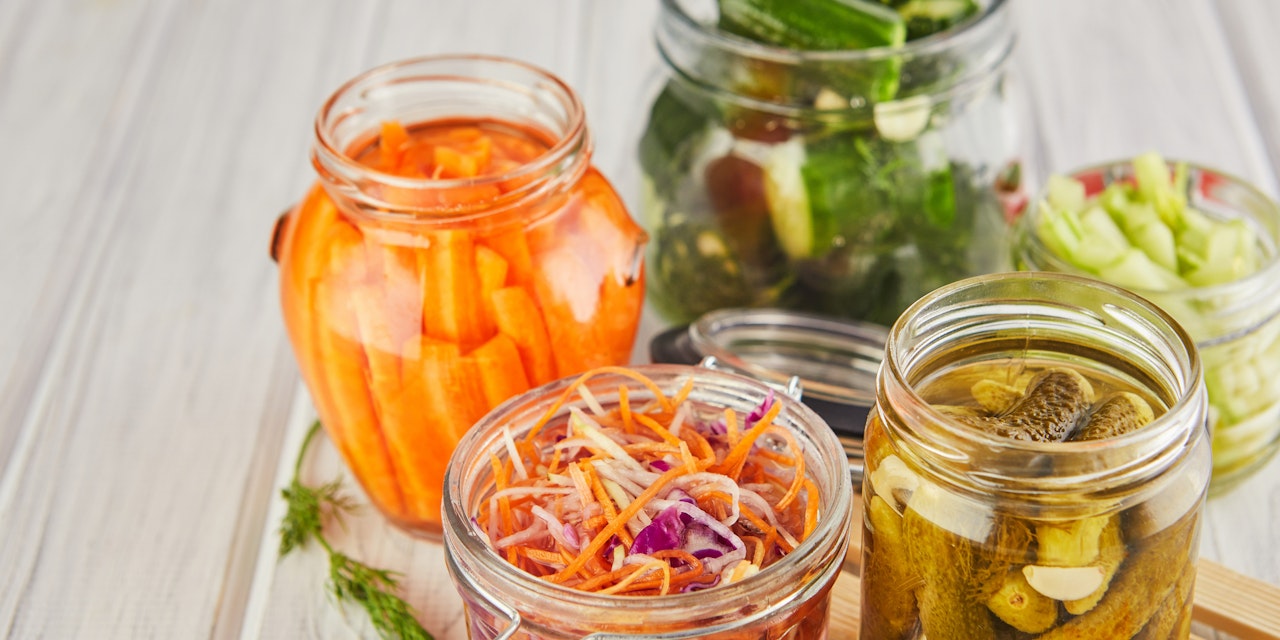Pickled Food
Learn about the health benefits of pickling, what foods are best to pickle, and how to get pickling today.
- Published: 2/11/2021
- Categories:
- 4 min. read

- Published: 2/11/2021
- Categories:
- 4 min. read
The series Portlandia coined the phrase “we can pickle that”, poking fun at how pickling has become a wellness fad, and obsession for some. This age-old process of food preservation extends shelf life, adds flavor and texture, and offers healthy bacteria for better digestion. Learn about the health benefits of pickling, what foods are best to pickle, and how to get pickling today.
Pickling versus fermenting: what’s the difference?
Fermenting and pickling are both ways to preserve food, resulting in additional health benefits and tangy flavors. It can get a bit confusing, but all fermented foods are pickled but not all pickled foods are fermented.
Pickled foods
The difference is that pickling involves soaking food in an acidic liquid such as vinegar, to preserve it and give it a sour flavor. Pickling preserves food by soaking it in a brine (salty water), or in an acidic liquid (vinegar or lemon juice). These foods usually also have seasonings such as garlic and dill added for extra flavor.
- Pickled foods: pickled cucumbers, sauerkraut and kimchi (pickled cabbage which is also fermented), pickled carrots, pickled onions, pickled pears, pickled grapes, pickled fish and meat.
Fermented foods
For fermented foods, the sour flavor happens as a result of healthy bacteria digesting the natural sugars, so no acid is required. Fermentation preserves food by natural bacteria digesting sugars and carbohydrates present in the food. It does so in an anaerobic (without oxygen) process (1). This doesn’t require an acidic liquid.
- Fermented foods: yogurt, kefir, sourdough bread, beer, wine, cider.
Benefits of pickled foods
Vitamins and minerals
Fruits and vegetables are naturally low in calories with a lot of vitamins and minerals. They contain nutrients such as fiber, which helps improve digestion, and vitamin C and A which help maintain healthy skin and boost the immune system (2).
When fruits and vegetables are pickled, the brine pulls out water from them, so they’re left with high concentrations of vitamins and minerals. Pickled foods that are also fermented, like kimchi and miso, can also help keep your digestive system healthy.
Healthy bacteria
The process of fermentation involves microorganisms, such as yeast and bacteria. Also called probiotics, these healthy bacteria assist with metabolism, digesting fiber, boosting the immune system, and creating vitamins such as vitamin K and some B vitamins. They’ve even been suggested to help improve mood (3). They have been shown to reduce the risk of heart disease, diabetes, obesity, and inflammation (1).
Prebiotics are the foods that feed these healthy bacteria probiotics. Prebiotics include asparagus, garlic, onions, and Jerusalem artichokes. So when you pickle these foods, you’ll be getting double the benefits!
Better for the environment
Making your own pickled fruits and vegetables is an easy way to extend the shelf life of produce and reduce food waste. This is particularly helpful during the winter months, when local produce may not be available. It can also help you save money. When you buy produce at its peak, it will be cheaper. The practice of pickling only requires a few ingredients and is quite simple and affordable.
How to pickle
Pickling can seem intimidating, but it's a pretty simple method. Just think about how it's one of the oldest preservation methods around (4). If our ancestors could do it, so can we!
What you’ll need
- Wide mouth glass jars: this can be store bought or saved from another food item you have. Just make sure to wash and sterilize the jars carefully before you use them for pickling.
- 1 pound (450 grams) vegetables: an easy place to start is with vegetables such as cabbage, green beans, radish, carrots, and beets.
- 1 cup white or apple cider vinegar: apple cider vinegar works nicely for fruit as well.
- 1-2 teaspoon herbs and spices: this can be up to your liking. Black pepper, dill, mustard, and garlic work well for vegetables.
- 1 cup water.
- 1 tablespoon sea salt.
Prepare for pickling
- Wash and slice vegetables as desired. Just make sure they will fit in your jars.
- Pack vegetables with herbs and spices of choice in the jars.
- Put vinegar, water, salt in a saucepan and heat over high until it boils and the salt is dissolved.
- Pour liquid over the vegetables until they are submerged. Leave a little space between the liquid and the top of the jar.
- Let the jars cool to room temperature then store them, sealed, in the refrigerator. Wait at least 48 hours and keep them for up to 2 months. The longer they sit, the more flavor you’ll get.
Get yourself out of a pickle and into pickling
Making foods at home is usually the healthiest option. Since pickling foods can increase your chance of bacteria that increase the risk of illness, make sure to use proper food handling techniques and carefully sterilize your jars.
If you have a compromised immune system, consider getting these foods from reputable sources. And if you’re buying your pickles and pickled foods at the store, aim for the versions that say “naturally pickled” and have minimal to no added preservatives for better health.
Want to put your pickling progress to the recipe test? Check this Sesame Salmon with Brussels Sprout- & Spinach Salad and a Spicy Kimchi Yogurt
4 references (hide)
All of the content and media on Lifesum is created and published for information purposes only. It is not intended to be used as a substitute for medical advice or treatment. Users should always consult with a doctor or other health care professional for medical advice. If you have or think you are at risk of developing an eating disorder, do not use the Lifesum app and seek immediate medical help.